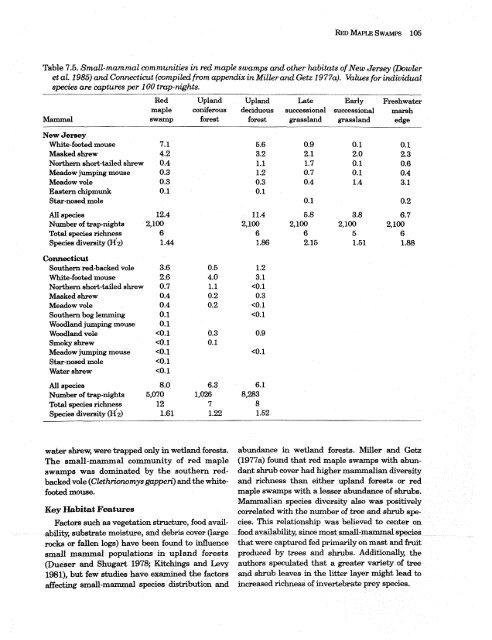Ecology of Red Maple Swamps in the Glaciated Northeast: A ...
Ecology of Red Maple Swamps in the Glaciated Northeast: A ...
Ecology of Red Maple Swamps in the Glaciated Northeast: A ...
You also want an ePaper? Increase the reach of your titles
YUMPU automatically turns print PDFs into web optimized ePapers that Google loves.
Table 7.5. Small-mammal communities <strong>in</strong> red maple swamps and o<strong>the</strong>r habitats <strong>of</strong> New Jersey (Dowkr<br />
et ~1.1985) and Connecticut (compiled from appendix <strong>in</strong> Miller and Getz 1977~). Values for <strong>in</strong>dividual<br />
species are captures per 100 tmp-nights.<br />
-- --<br />
<strong>Red</strong> Upland Upland Late Early Freshwater<br />
maple coniferous deciduous successional successional marsh<br />
Mammal swamp forest forest grassland grassland edge<br />
New Jersey<br />
White-footed mouse 7.1<br />
Masked shrew 4.2<br />
Nor<strong>the</strong>rn short-tailed shrew 0.4 1.1 1.7 0.1 0.6<br />
Meadow jump<strong>in</strong>g mouse 0.3<br />
Meadow vole 0.3<br />
Eastern chipmunk 0.1<br />
Star-nosed mole<br />
All species 12.4 11.4 5.8 3.8 6.7<br />
Number <strong>of</strong> trap-nights 2,100 2,100 2,100 2,100 2,100<br />
Total species richness 6 6 6 5 6<br />
Species diversity (H'z) 1.44 1.86 2.15 1.51 1.88<br />
Connecticut<br />
Sou<strong>the</strong>rn red-backed vole<br />
White-footed mouse<br />
Nor<strong>the</strong>rn short-tailed shrew<br />
Masked shrew<br />
Meadow vole<br />
Sou<strong>the</strong>rn bog lemm<strong>in</strong>g<br />
Woodland jump<strong>in</strong>g mouse<br />
Woodland vole<br />
Smoky shrew<br />
Meadow jump<strong>in</strong>g mouse<br />
Star-nosed mole<br />
Water shrew<br />
All species 8.0 6.3 6.1<br />
Number <strong>of</strong> trap-nighta 5,070 1,026 8,283<br />
Total species richness 12 7 8<br />
Species diversity (33'2) 1.61 1.22 1.52<br />
water shrew, were trapped only <strong>in</strong> wetland forests.<br />
The small-mammal community <strong>of</strong> red maple<br />
swamps was dom<strong>in</strong>ated by <strong>the</strong> sou<strong>the</strong>rn redbacked<br />
vole (Clethriommysgapperi) and <strong>the</strong> whitefooted<br />
mouse.<br />
Key Habitat Features<br />
Factors such as vegetation structure, food availability,<br />
substrate moisture, and debris cover (large<br />
rocks or fallen logs) have been found to <strong>in</strong>fluence<br />
small mammal populations <strong>in</strong> upland forests<br />
(Dueser and Shugart 1978; Kitch<strong>in</strong>gs and Levy<br />
1981), but few studies have exam<strong>in</strong>ed <strong>the</strong> factors<br />
affect<strong>in</strong>g small-mammal species distribution and<br />
abundance <strong>in</strong> wetland forests. Miller and Getz<br />
(1977a) found that red maple swamps with abundant<br />
shrub cover had higher mammalian diversity<br />
and richness than ei<strong>the</strong>r upland forests or red<br />
maple swamps with a lesser abundance <strong>of</strong> shrubs.<br />
Mammalian species diversity also was positively<br />
correlated with <strong>the</strong> number <strong>of</strong> tree and shb<br />
species.<br />
This relationship was believed to center on<br />
food availability, s<strong>in</strong>ce most small-mammal species<br />
that were captured fed primarily on mast and fruit<br />
produced by trees and shrubs. Additionally, <strong>the</strong><br />
authors speculated that a greater variety <strong>of</strong> tree<br />
and shrub leaves <strong>in</strong> <strong>the</strong> litter layer might lead to<br />
<strong>in</strong>creased richness <strong>of</strong> <strong>in</strong>vertebrate prey species.

















